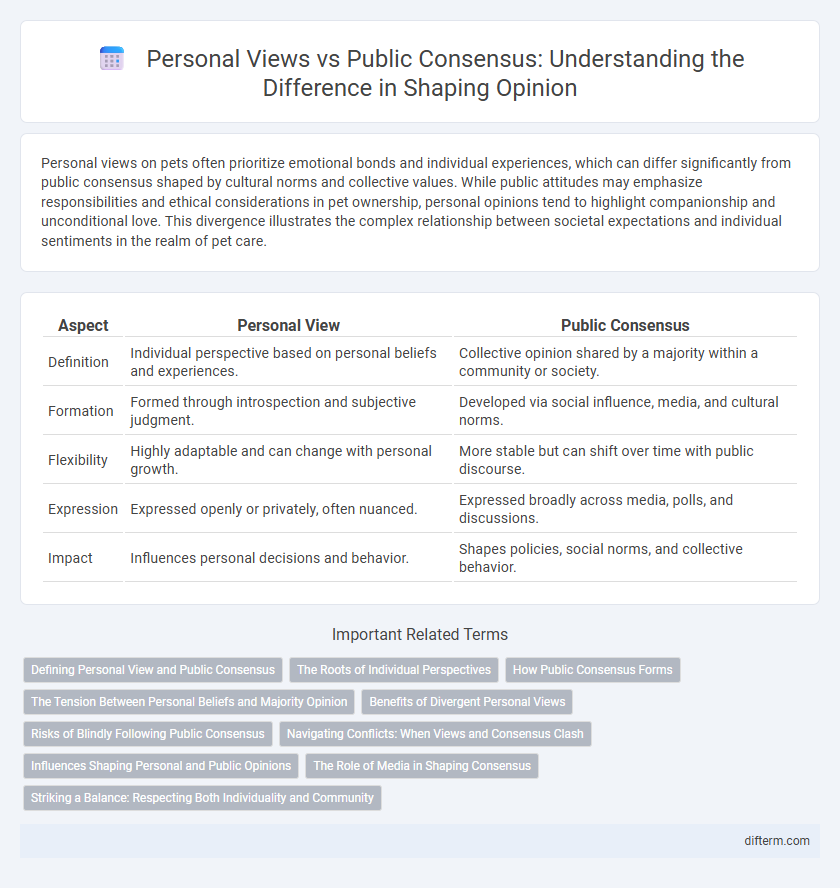Personal views on pets often prioritize emotional bonds and individual experiences, which can differ significantly from public consensus shaped by cultural norms and collective values. While public attitudes may emphasize responsibilities and ethical considerations in pet ownership, personal opinions tend to highlight companionship and unconditional love. This divergence illustrates the complex relationship between societal expectations and individual sentiments in the realm of pet care.
Table of Comparison
| Aspect | Personal View | Public Consensus |
|---|---|---|
| Definition | Individual perspective based on personal beliefs and experiences. | Collective opinion shared by a majority within a community or society. |
| Formation | Formed through introspection and subjective judgment. | Developed via social influence, media, and cultural norms. |
| Flexibility | Highly adaptable and can change with personal growth. | More stable but can shift over time with public discourse. |
| Expression | Expressed openly or privately, often nuanced. | Expressed broadly across media, polls, and discussions. |
| Impact | Influences personal decisions and behavior. | Shapes policies, social norms, and collective behavior. |
Defining Personal View and Public Consensus
Personal views are individual beliefs shaped by unique experiences, emotions, and values, often reflecting subjective interpretation. Public consensus represents the collective agreement or general acceptance of ideas within a community or society, typically derived from shared information and common interests. Understanding the distinction between personal view and public consensus is crucial for evaluating diverse perspectives and fostering informed discussions.
The Roots of Individual Perspectives
Individual perspectives stem from unique life experiences, cultural backgrounds, and personal values, forming a foundation distinct from public consensus. These roots shape how people interpret information, react to events, and prioritize issues, often leading to divergent opinions within a society. Understanding the origins of personal viewpoints enhances appreciation for the complexity behind public debates and collective decision-making.
How Public Consensus Forms
Public consensus forms through the aggregation of diverse personal views influenced by cultural norms, media exposure, and social interactions. Collective agreement emerges as individuals negotiate conflicting opinions, often guided by authoritative information and majority trends. This dynamic process reflects the balance between individual perspectives and the shared understanding within a community.
The Tension Between Personal Beliefs and Majority Opinion
The tension between personal beliefs and majority opinion arises when individual values conflict with widely accepted societal norms, creating a complex dynamic of self-expression and conformity. Navigating this divide requires balancing authenticity with the need for social acceptance, often leading to inner conflict or social friction. Understanding the cognitive biases and social pressures that influence public consensus can help individuals critically evaluate majority views without abandoning their personal convictions.
Benefits of Divergent Personal Views
Divergent personal views foster innovation and creativity by challenging mainstream ideas and encouraging unique problem-solving approaches. They promote critical thinking and resilience within society, enabling adaptation to complex challenges through diverse perspectives. Embracing varied opinions enhances democratic discourse and prevents the stagnation that often accompanies strict public consensus.
Risks of Blindly Following Public Consensus
Blindly following public consensus risks undermining critical thinking and personal judgment, potentially leading to the spread of misinformation. Social conformity can suppress diverse perspectives, resulting in groupthink that hinders innovation and problem-solving. Relying solely on popular opinion increases vulnerability to manipulation by dominant narratives or influential entities.
Navigating Conflicts: When Views and Consensus Clash
Navigating conflicts between personal views and public consensus requires balancing individual beliefs with societal norms to find common ground. Ethical decision-making thrives when diverse perspectives are respected, fostering constructive dialogue despite disagreements. Recognizing the value of both personal insight and collective wisdom promotes social cohesion and informed solutions.
Influences Shaping Personal and Public Opinions
Personal opinions are molded by individual experiences, values, and emotions, creating a unique perspective often resistant to popular influence. Public consensus emerges from collective interactions, media narratives, and cultural norms, reflecting a broader societal viewpoint. The dynamic interplay between personal beliefs and public consensus highlights how social networks and information ecosystems shape opinions.
The Role of Media in Shaping Consensus
Media outlets play a crucial role in shaping public consensus by selectively highlighting certain opinions and framing narratives that influence collective perception. The amplification of dominant viewpoints through news platforms and social media algorithms often marginalizes minority perspectives, impacting the diversity of public discourse. Consequently, the interplay between media representation and audience reception determines the extent to which personal views align with or diverge from the prevailing consensus.
Striking a Balance: Respecting Both Individuality and Community
Striking a balance between personal view and public consensus is essential for fostering mutual respect and understanding within a community. Honoring individuality encourages diverse perspectives that enrich collective decision-making while maintaining social cohesion. Emphasizing empathy and open dialogue bridges differences, allowing both personal beliefs and community values to coexist harmoniously.
personal view vs public consensus Infographic

 difterm.com
difterm.com